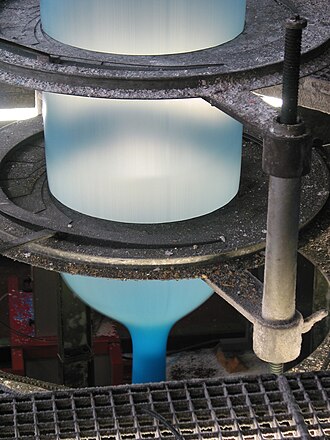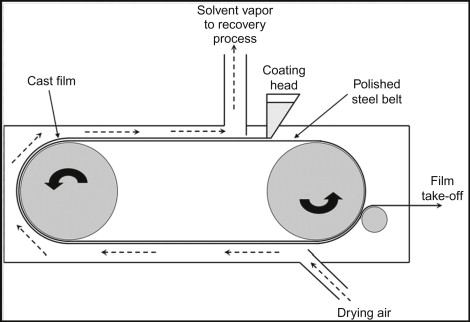
- > Search By Functions
- > Co-Extrusion
- > Search By Material
- > Search By Machines
- > Search By Machines
- > Search By Machines
What are you looking for?
In the world of plastic film manufacturing, two common processes reign supreme: blown film and casting film. These processes are pivotal in creating the flexible packaging and films we see wrapped around products every day. But what’s the difference between the two? How do they compare in terms of production, quality, and application?
Understanding the distinctions between blown film and casting film can help businesses choose the most suitable option for their needs. Both processes have their strengths and weaknesses, and your decision may depend on the desired properties of the final product.
Brief Overview of Film Extrusion
Film extrusion is the foundation of both blown and cast film production. This process involves melting plastic resin, then shaping and cooling it into thin films used in everything from food packaging to industrial applications. Both blown and cast film use different techniques to achieve this, resulting in distinct characteristics for each type of film.
Importance of Understanding Blown and Casting Film
Why does it matter whether a film is blown or cast? The answer lies in their physical properties, cost, and usability. Depending on what you need—be it strength, clarity, or cost efficiency—the choice between blown and casting film can make all the difference in your product's performance.
Blown film is a widely-used technique for producing plastic films, and its hallmark is the way it's formed. Let's dive into how the blown film extrusion process works.
The Process of Blown Film Extrusion
Blown film extrusion involves melting plastic pellets and forming them into a tube that is expanded, or "blown," into a bubble-like shape.
Material Preparation
The process starts with feeding plastic resin (often polyethylene) into an extruder. This machine heats the resin until it reaches a molten state, ready to be shaped.
Blowing and Cooling Stage
Once molten, the material is extruded through a circular die, forming a thin tube. Air is then blown into the tube, inflating it into a bubble. As the bubble expands, it cools and forms the thin film. The bubble is collapsed and flattened, then wound onto a reel.
Characteristics of Blown Film
Blown films tend to have specific qualities that make them unique compared to cast films.
Strength and Durability
Due to the biaxial stretching during the blowing process, blown films are strong and durable, able to withstand stress in multiple directions. This makes them perfect for applications that require high tensile strength.
Versatility in Applications
Blown films are known for their adaptability. They can be used in various thicknesses and tailored to specific applications, from food packaging to industrial wraps.
Applications of Blown Film
Blown films find their way into several industries, including:
Packaging Industry
Blown films are widely used in the packaging industry for products like grocery bags, stretch wraps, and shrink films due to their strength and flexibility.
Agricultural Films
In agriculture, blown films are used for mulching, greenhouses, and silage covers, where durability is critical in outdoor conditions.

Image from Wikipedia
Casting film, or cast film, is another method of producing thin plastic films but follows a completely different process from blown film.
The Process of Cast Film Extrusion
Instead of inflating the film into a bubble, cast film is extruded through a flat die and then quickly cooled.
Material Preparation
Like blown film, plastic resin is heated in an extruder until it melts. However, the casting process uses a flat die instead of a circular one.
Casting and Cooling Stage
The molten plastic is extruded as a flat sheet onto a cooling roll, which solidifies it instantly. This quick cooling ensures that the film has a smooth, glossy finish and consistent thickness.
Characteristics of Cast Film
Clarity and Gloss
One of the standout features of cast films is their exceptional clarity and gloss. The rapid cooling process preserves the transparency of the film, making it ideal for products where appearance matters.
Uniform Thickness
Cast films are known for their uniformity in thickness, which is crucial for certain applications like food packaging, where consistency is key.
Applications of Cast Film
Food Packaging
Cast films are often used in food packaging due to their clarity and barrier properties, making products more appealing on shelves.
Medical and Industrial Uses
In medical and industrial settings, cast films are valued for their high-quality finish and consistent performance, providing reliable protection for sensitive products.

Image from Science Direct
Now that we understand the processes behind each type of film, let’s explore the critical differences between blown and cast film.
The main distinction lies in how the films are formed. Blown film involves inflating a bubble, while cast film is laid flat and cooled on rollers.
Strength and Stretchability
Blown films have higher strength due to their biaxial stretching during the blowing process. On the other hand, cast films lack this stretching and therefore aren't as strong but have greater flexibility in terms of thickness.
Clarity and Appearance
Cast films are known for their superior clarity and high-gloss finish, whereas blown films are usually hazy and less clear due to slower cooling and stretching.
Manufacturing Costs
Blown film tends to have lower manufacturing costs because the process is slower, and it uses fewer energy resources compared to casting. However, blown film machinery is often more expensive.
Final Product Pricing
Because cast film has a faster production speed, it is often more cost-effective in high-volume operations, resulting in lower pricing for the end product compared to blown film.
Cast films are produced more quickly than blown films. This is because the cast film process involves fewer steps and the film is cooled faster.
Blown film allows for more customization in terms of thickness and flexibility, whereas cast film offers better control over uniformity and aesthetics.
High Strength and Durability
Blown films stand out for their strength, which makes them ideal for heavy-duty applications like industrial packaging.
Versatility in Application
Their adaptability allows them to be used in various industries, from agriculture to food packaging.
Slower Production Speed
The blown film process takes more time, leading to lower production output compared to casting film.
Thicker Film Limitations
Blown films typically result in thicker films, which may not be suitable for applications requiring ultra-thin films.
Superior Clarity and Gloss
If appearance is a priority, cast film wins with its excellent clarity and glossy finish.
Fast Production Speed
Cast film can be produced at a much faster rate, making it more cost-effective for large-scale production.
Lower Strength and Durability
Cast films are not as strong as blown films, which can limit their use in heavy-duty applications.
Limited Stretchability
Cast films don’t have the same level of stretchability, making them less ideal for applications that require flexibility.
The decision between blown and cast film largely depends on the application. If you need strength and versatility, blown film might be the better choice. However, if you’re looking for clarity and high-volume production, cast film is often the way to go.
Application-Specific Decisions
Choosing between blown and cast film depends on the specific needs of your product—whether it’s food packaging, industrial use, or agriculture.
Cost vs. Performance
Ultimately, the choice may come down to budget constraints. Blown films offer durability but come with slower production times, while cast films offer speed and cost efficiency but might not provide the same strength.
In summary, both blown and cast films have their place in the plastic film industry, each offering unique benefits depending on the required properties. Blown film is durable and versatile, while cast film is fast to produce and aesthetically pleasing. Understanding the differences between the two can guide you in selecting the most suitable type of film for your specific application.